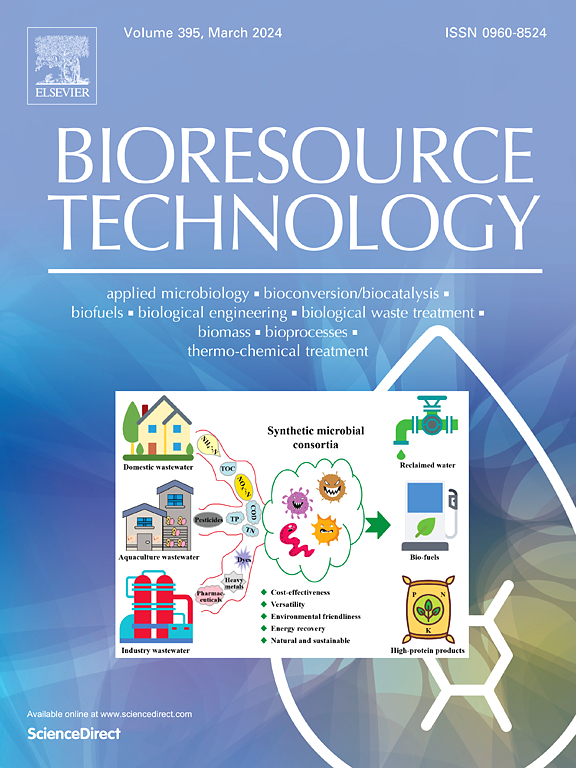调节环糊精糖基转移酶糖基化反应的限速步骤以高效生产糖基化多酚
IF 9.7
1区 环境科学与生态学
Q1 AGRICULTURAL ENGINEERING
引用次数: 0
摘要
CD络合增溶作用和酶糖基化作用协同促进生物质对多酚的利用。在环糊精(CD)动态配位的高效糖基化体系中,提出了调节β-CD开环效率(k1)超过CGTase催化大豆苷基化效率(k2)的限速步骤的综合策略。该方法包括系统调节CD:多酚的摩尔比和浓度,以及合理的CGTase工程,以提高多酚的糖基化收率。通过分子对接和序列比对,确定了受体亚位+1和+3附近的关键残基Y195和E264。基于增强疏水性和降低位阻的原理,对这两个残基进行定点诱变,筛选得到7个多酚糖基化效率提高的单突变体。半反应动力学分析表明,突变体Y195F、E264A和E264V成功地缩小了k1和k2之间的差距。最后,构建双突变体Y195F/E264A和Y195F/E264V,其糖基化率高于单突变体。最优突变体Y195F/E264V在水中大豆苷7-O-α-d-葡萄糖苷(65.6%)和芦丁4″-O-α-d-葡萄糖苷(89.4%)的产量最高,分别比野生型(WT)高出37.4%和8.3%。该研究为植物生物量的增值提供了一种通用的方法,具有在植物多酚利用中可扩展应用的潜力。本文章由计算机程序翻译,如有差异,请以英文原文为准。
Regulating the rate-limiting step of cyclodextrin glycosyltransferase glycosylation reaction for efficient production of glycosylated polyphenols
CD complexation solubilization and enzymatic glycosylation synergistically enhance the utilization of polyphenols in biomass. In this study, a comprehensive strategy was proposed, to regulate the rate-limiting step where the efficiency of β-CD ring-opening (k1) exceeded the daidzein glycosylation (k2) catalyzed by CGTase in the efficient glycosylation system based on cyclodextrin (CD) dynamic complexation. This approach involved systematic regulation of the CD:polyphenol molar ratio and concentration, along with rational CGTase engineering, to enhance the glycosylation yield of polyphenols. Through molecular docking and sequence alignment, key residues Y195 and E264 near the acceptor subsites +1 and +3 were identified. Based on the principles of enhancing hydrophobicity and reducing steric hindrance, site-directed mutagenesis was performed on the two residues, and screening obtained seven single mutants with improved polyphenol glycosylation efficiency. The half-reaction kinetics analysis showed that mutants Y195F, E264A and E264V successfully narrowed the gap between k1 and k2. Finally, the double mutants Y195F/E264A and Y195F/E264V were constructed, which showed higher glycosylation yields than single mutants. The optimal mutant Y195F/E264V achieved the highest reported yields of daidzein 7-O-α-d-glucopyranoside (65.6 %) and rutin 4″-O-α-d-glucopyranoside (89.4 %) in water, surpassing the wild-type (WT) by 37.4 % and 8.3 %, respectively. The study presents a universal approach for the valorization of plant biomass, with the potential for scalable application in plant polyphenol utilization.
求助全文
通过发布文献求助,成功后即可免费获取论文全文。
去求助
来源期刊

Bioresource Technology
工程技术-能源与燃料
CiteScore
20.80
自引率
19.30%
发文量
2013
审稿时长
12 days
期刊介绍:
Bioresource Technology publishes original articles, review articles, case studies, and short communications covering the fundamentals, applications, and management of bioresource technology. The journal seeks to advance and disseminate knowledge across various areas related to biomass, biological waste treatment, bioenergy, biotransformations, bioresource systems analysis, and associated conversion or production technologies.
Topics include:
• Biofuels: liquid and gaseous biofuels production, modeling and economics
• Bioprocesses and bioproducts: biocatalysis and fermentations
• Biomass and feedstocks utilization: bioconversion of agro-industrial residues
• Environmental protection: biological waste treatment
• Thermochemical conversion of biomass: combustion, pyrolysis, gasification, catalysis.
 求助内容:
求助内容: 应助结果提醒方式:
应助结果提醒方式:


